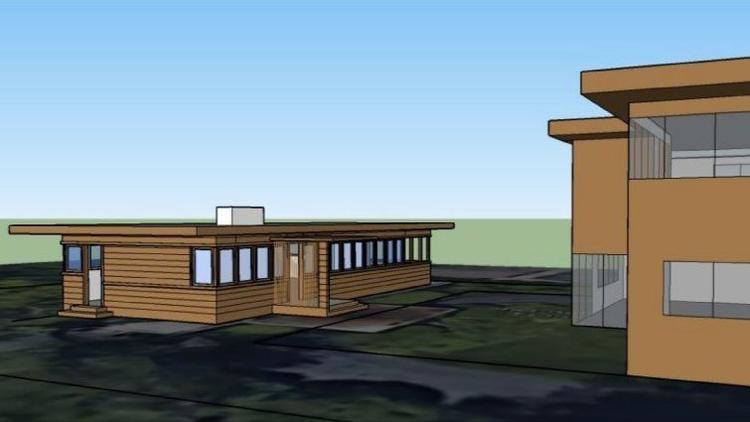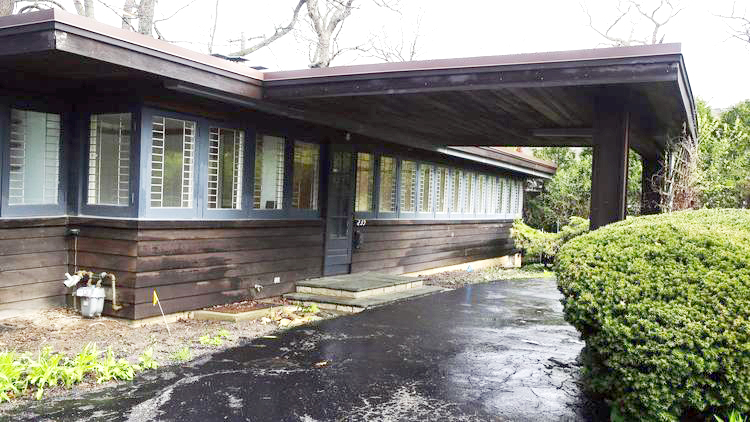Even if you’re not an architecture buff, there's a good chance you’ve heard of Frank Lloyd Wright. Tourists from around the world flock to his most famous works, including the Guggenheim Museum, Fallingwater, and Chicago’s own Robie House.
But this week, a lesser-known Wright building in Glencoe is getting lots of attention for a different reason: It might become the first Wright-designed home to be torn down in 15 years.
In 1915, Wright's attorney, Sherman Booth, commissioned the architect to transform a part of Glencoe into what's now known as the Ravine Bluffs development. Wright's original plans included a train station and 25 houses, but in the end, he built just three concrete sculptures, a bridge, and six residences — including Booth’s permanent home.
The cottage currently under threat at 239 Franklin Road was built in 1913 as a temporary residence for the Booth family while their larger house was under construction. When Booth's main home was completed three years later, the cottage was moved to its present location on Franklin Road, right outside the development.
In October 2017, the cottage was listed for $1 million by the daughter of its late owners, the Rudoffs, who had lived there since 1956. The new owners bought it for nearly half that, $555,000, on May 9, then applied for what Glencoe calls an incomplete demolition permit.
In any other town, a Frank Lloyd Wright home — even one built as a temporary structure — would likely have legal protection against demolition. But Glencoe is different.
The village has two types of landmark designation: honorary and certified. Only the latter protects a historic structure from demolition. The Booth Cottage is an honorary landmark, meaning it's subject to a 180-day delay in demolition (from May 9 in this case), but not exempt. Ravine Bluffs itself is not part of a local historic district, and only one of the homes has been officially certified.
Surprisingly, two homes in Ravine Bluffs haven’t even been landmarked at all. Architect John Eifler, a former member of Glencoe’s Historic Preservation Commission who restored the William F. Ross House in Ravine Bluffs, says Glencoe provides "little or no protection" for historic buildings, because the village board tends to believe that even an honorary landmark designation infringes on owners' property rights.
The Sherman Booth Cottage was moved once before, but it looks like Glencoe is not interested in moving it again. In February, knowing the house was up for sale and possibly threatened, the Historic Preservation Commission entertained moving the cottage to park district property as an alternative to demolition. That request was denied by Glencoe's park district, which, according to Eifler, didn't want to shoulder the responsibility of maintaining it. The house could possibly be moved by outside entities like the Frank Lloyd Wright Building Conservancy, but that's still up in the air.

As teardowns become more common across the country, one might ask if a single house is worth all the trouble. Considering it was built as temporary housing (and supposedly sketched by Wright on a brown paper bag), the architect himself might be surprised to see the building still standing.
And though the Booth Cottage would be the first Wright-designed residence to come down since 2004, when a Michigan beach house was destroyed to make room for a larger home, another nonresidential Wright building — the Lockridge Medical Clinic in Whitefish, Montana — came down as recently as last year.
But that the structure has survived for this long — 106 years — may make it even more worthy of preservation. Architecture enthusiasts also point to the Booth Cottage's contextual significance: Many see it as a precursor to Wright’s later Usonian homes and a crucial component of the Ravine Bluffs development.
Regardless of the Booth Cottage's fate, its possible demolition spotlights a larger crack in Glencoe's historic preservation ordinance. The village's built environment boasts homes designed by a number of famous architects besides Wright, including David Adler, Howard Van Doren Shaw, William W. Boyington, S.S. Beman, Keck & Keck, Bertrand Goldberg, and Edward Dart.
The Wright cottage isn't the only contentious possible demolition in Glencoe, either. A developer recently bought the Hoover Estate, built by the family that began the vacuum empire, and plans to tear down all its buildings — including a 10,000 square foot mansion — and replace them with a 29-lot subdivision.
Which raises the question: why does Glencoe's honorary distinction exist, if not to preserve such structures? If the village intended to have real historic preservation rules in place, instead of in name only, people wouldn’t be talking about ways to save the Booth cottage. It would already be saved.



